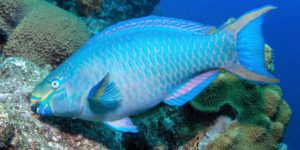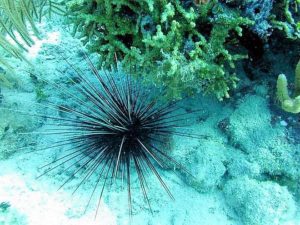One of my favorite activities is fish watching on the beautiful coral reefs of the Florida Keys. To me, parrotfish (algae grazers) are the most entertaining fish species to observe. It’s fun watching them zoom around, using their pectoral fins for propulsion. There are 13 different types of parrotfish found in the Keys. Each one can be found in a different color phase, depending on their age and sex. Most parrotfish are sequential hermaphrodites, which means that they begin their lives as females and then later turn into males. This change is often accompanied by a color change.
 Parrotfish also have an interesting feeding behavior. Snorkelers and scuba divers can actually hear them feeding while swimming around the reef. Parrotfish feed on algae and other organisms that grow on the coral reef. Scraping and crunching sounds are made when their beak-like mouthparts scrape the coral to eat the algae or sponges that grow on it. With their sharp “beak,” they can remove little bits of coral with each mouthful. The coral is crushed with special teeth located in their throats and continues to break down further during digestion. During this process, parrotfish create sand. In fact, a parrotfish can produce up to a ton of sand in its lifetime. This sand settles around the coral reefs and eventually will wash up onto the beaches in the Caribbean. In other words, the beaches are made of parrotfish poop.
Parrotfish also have an interesting feeding behavior. Snorkelers and scuba divers can actually hear them feeding while swimming around the reef. Parrotfish feed on algae and other organisms that grow on the coral reef. Scraping and crunching sounds are made when their beak-like mouthparts scrape the coral to eat the algae or sponges that grow on it. With their sharp “beak,” they can remove little bits of coral with each mouthful. The coral is crushed with special teeth located in their throats and continues to break down further during digestion. During this process, parrotfish create sand. In fact, a parrotfish can produce up to a ton of sand in its lifetime. This sand settles around the coral reefs and eventually will wash up onto the beaches in the Caribbean. In other words, the beaches are made of parrotfish poop.
 The grazing activity of parrotfish is not only fun to watch, but parrotfish also play an important role on the reef by keeping the algae in check. Sea urchins, damselfish and surgeonfish are also important algae grazers on the reef. It is vital for the algae on the reef to be kept in check; otherwise, the algae can easily grow over the corals and kill them. Unfortunately, one of our most important grazers suffered a massive die off in the early 1980s and their population has yet to recover. Longtime residents of the Keys may remember when long-spined sea urchins were so plentiful that they dotted the reefs and rubble areas. Today, long-spined sea urchin numbers are recovering, but very slowly. With the decrease of the urchins, and increased nutrient levels in the water, the remaining algae grazers cannot keep up with algae growth.
The grazing activity of parrotfish is not only fun to watch, but parrotfish also play an important role on the reef by keeping the algae in check. Sea urchins, damselfish and surgeonfish are also important algae grazers on the reef. It is vital for the algae on the reef to be kept in check; otherwise, the algae can easily grow over the corals and kill them. Unfortunately, one of our most important grazers suffered a massive die off in the early 1980s and their population has yet to recover. Longtime residents of the Keys may remember when long-spined sea urchins were so plentiful that they dotted the reefs and rubble areas. Today, long-spined sea urchin numbers are recovering, but very slowly. With the decrease of the urchins, and increased nutrient levels in the water, the remaining algae grazers cannot keep up with algae growth.
Many areas are showing signs of becoming overgrown with algae. Many scientists study these environmental problems and work towards solutions; however, you don’t have to be a scientist to help. Our everyday actions can make a big difference to the marine environment. One way you can help is by becoming a citizen scientist with one of the many local environmental groups working to protect the ocean environment. As a citizen scientist, you may help track fish populations with Reef Environmental Education Foundation or record coral bleaching or plant new corals with the Coral Restoration Foundation. Another way to help is by working to stop marine pollution.
To learn more about how you can help, contact a state park near you at floridastateparks.org. Becky Collins is a ranger at John Pennekamp Coral Reef State Park.
